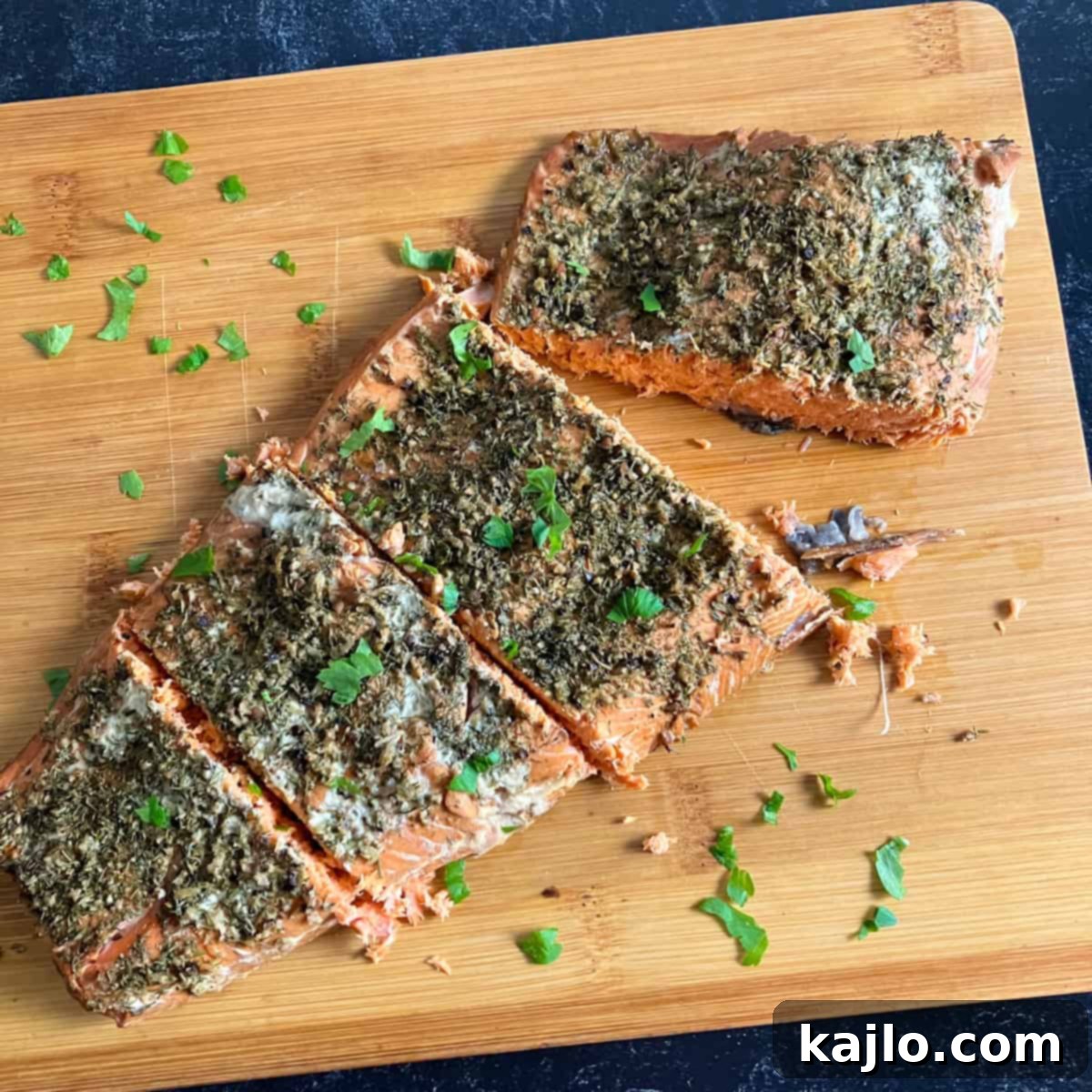Unlock the secrets to perfectly smoked salmon right in your kitchen! This comprehensive guide answers your most pressing questions: “How long to smoke salmon at 200 degrees F (93C)?” and “What is the ideal smoked salmon temperature?” Whether you’re using a quick Nordic Ware stovetop smoker or a traditional pellet smoker, we’ll provide precise smoking times and temperatures. Beyond the numbers, you’ll discover the best wood chips for infusing that perfect smoky flavor, the crucial step of forming a pellicle, and a wealth of tips to ensure your hot smoking endeavors are a resounding success. Prepare to transform ordinary salmon into an extraordinary culinary delight!
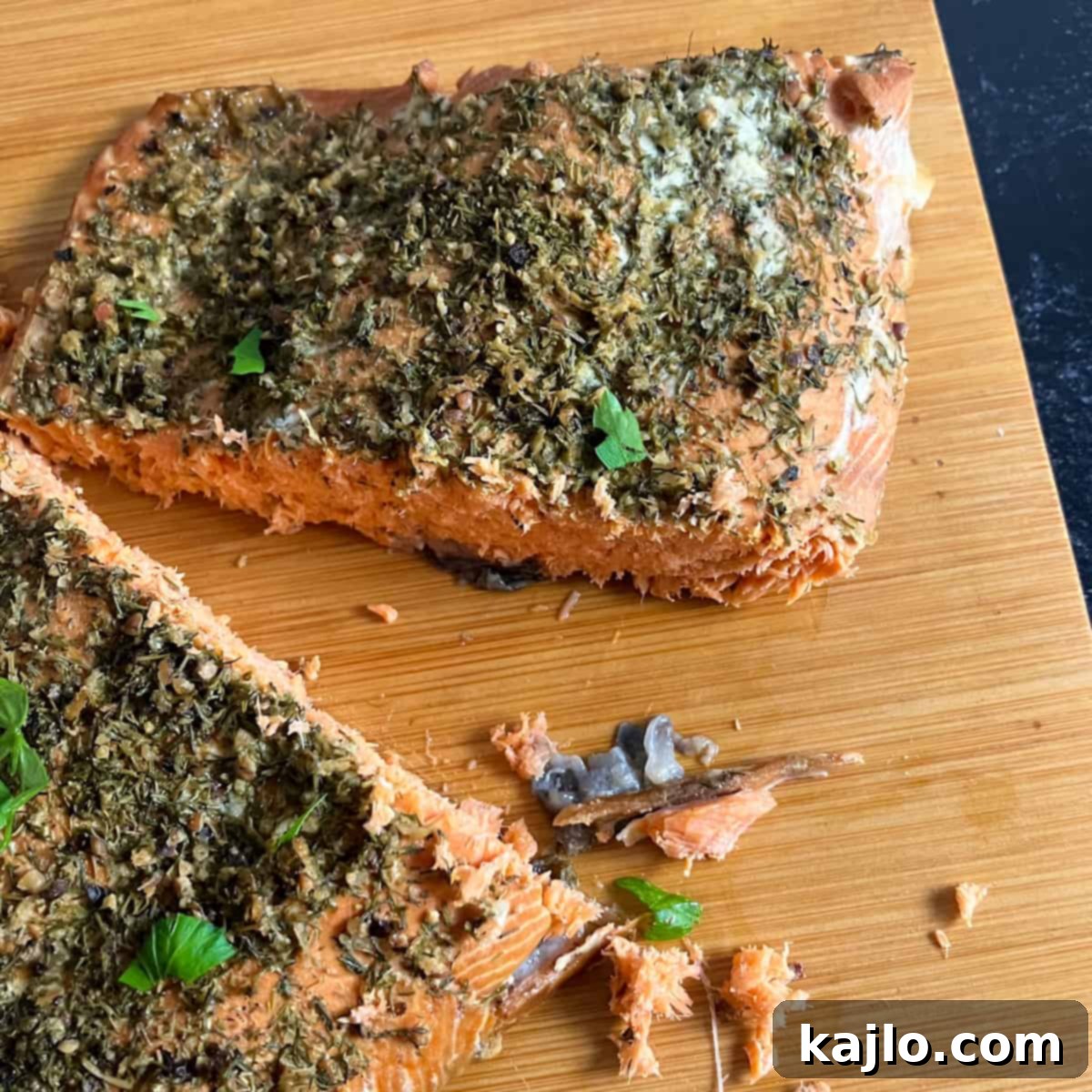
The journey to creating succulent hot-smoked salmon is an art, and the duration varies significantly based on your chosen cooking temperature and equipment. A stovetop smoker, designed for rapid smoking, operates differently from a classic outdoor smoker, demanding different timeframes for optimal results.
Smoking your own salmon is not just a rewarding culinary experience; it’s also a smart way to save money and customize flavors to your exact preferences. Unlike store-bought varieties that often include excessive brown sugar or honey, making it yourself allows you to control the sweetness, experiment with your favorite herbs, and select the perfect wood chips for a unique smoky profile. The possibilities for flavor customization are endless once you master the art of smoking salmon at home!
Today, we’ll guide you through the essential steps of brining and preparing salmon for smoking. This method works beautifully with both wild-caught and farm-raised salmon fillets. Regardless of your choice, crafting homemade smoked salmon is almost always more economical than purchasing it from a gourmet store.
For instance, a pound of fresh sockeye salmon might cost around $15-20, while the equivalent amount of hot-smoked sockeye can easily fetch upwards of $40 per pound. Even with more affordable Atlantic salmon, the smoked version commands a premium. By taking the reins in your kitchen, you gain control over both quality and cost.
This article will cover the fundamentals of smoking fish, whether you own a compact Nordic Ware stovetop smoker, an electric smoker, or a robust pellet grill. We’ll provide a clear smoked salmon time and temperature chart tailored for various types of smoking equipment, ensuring you have the knowledge to achieve perfect results every time.
⏲️ Smoked Salmon Temperature Chart
Understanding the right temperature and duration is paramount for excellent smoked salmon. It’s crucial to note that cooking times for a stovetop smoker, such as the Nordic Ware model, are considerably shorter than those for larger electric smokers or pellet grills. Additionally, the ideal smoking temperatures can differ between these devices. While the Nordic Ware smoker typically performs best between 190-210°F, other smoker brands might require different temperature settings for optimal results.
Here’s a detailed chart outlining smoked salmon temperatures and approximate smoking times across different smoker types:
| Temperature | Kettle Smoker Time (Nordic Ware) | Electric Smoker or Grill Time |
|---|---|---|
| 150°F (66°C) | Not recommended | Not recommended |
| 160°F (71°C) | Not recommended | Not recommended |
| 170°F (77°C) | Not recommended | 2½-3 hours |
| 180°F (82°C) | Not recommended | 2-2½ hours |
| 190°F (88°C) | 20-30 minutes | 2-2½ hours |
| 200°F (93°C) | 20-30 minutes | 2 hours |
| 210°F (99°C) | 20-30 minutes | 2 hours |
| 220°F (104°C) | Not recommended | 1½-2 hours |
| 225°F (107°C) | Not recommended | 1½-2 hours |
| 250°F (121°C) | Not recommended | 60-90 minutes |
| 275°F (135°C) | Not recommended | 60-90 minutes |
| 300°F (149°C) | Not recommended | 30-60 minutes |
The smoking times provided are given in ranges because the exact duration can vary based on the thickness of your salmon pieces. You’ll find a wide array of smoked salmon recipes online, making this table an excellent starting point. For instance, some recipes, like those from Traeger, suggest smoking salmon for 3-4 hours at 225°F.
Remember, hot smoked salmon is considered done only when it reaches a safe internal temperature. We’ll delve into more details about this critical aspect further down.
How Long to Smoke Salmon at 150 Degrees
Smoking salmon at temperatures as low as 150°F (66°C) is generally not recommended for hot smoking. Food safety guidelines often advise that hot-smoked salmon should reach a minimum internal temperature of 160°F (71°C) to effectively reduce the risk of harmful bacteria. If smoked at too low a temperature, the fish may not achieve this crucial internal heat, compromising its safety.
How Long to Smoke Salmon at 160
From a registered dietitian’s perspective, 160°F (71°C) is also considered too low for smoking salmon, especially for an extended period, as it approaches the lower end of the safe internal temperature spectrum for fish. Furthermore, many smokers, particularly those designed for higher heat or longer smoking periods, may not even be capable of maintaining such a low temperature consistently, making it impractical for most home smokers.
How Long to Smoke Salmon at 180
If you’re smoking salmon at 180°F (82°C) in an electric or pellet smoker, anticipate a cooking time of approximately 2 to 2½ hours. It is absolutely vital to use a reliable meat thermometer to verify that the salmon reaches a safe internal temperature before you consider it ready to serve. This temperature provides a gentle smoke, allowing flavors to slowly permeate the fish without drying it out too quickly.
How Long to Smoke Salmon at 190
For smoking salmon at 190°F (88°C), the cooking duration will depend on your equipment. In an electric smoker or pellet grill, expect it to take between 2 to 2½ hours. If you’re utilizing a stovetop smoker, the process is much quicker, typically requiring only 20-30 minutes. Always confirm the salmon’s internal temperature with a meat thermometer to ensure it reaches a safe level before serving, regardless of the smoking method.
How Long to Smoke Salmon at 200°F (93°C)
Smoking salmon at 200°F (93°C) is a popular and effective temperature. In an electric smoker or pellet grill, this will typically take around 2 hours. If you’re using a stovetop smoker, the smoking time is significantly reduced to about 20-30 minutes. As with all smoking methods, the most important step is to use a meat thermometer to ensure the salmon reaches its safe internal temperature before you remove it from the smoker and serve.
How Long to Smoke Salmon at 220
Smoking salmon at 220°F (104°C) is a slightly hotter approach that can speed up the cooking process. At this temperature, expect to smoke your salmon for about 1½ to 2 hours. It’s a good reminder that fish generally smokes faster than larger cuts of meat and poultry, so always monitor its internal temperature closely to prevent overcooking.
How Long to Smoke Salmon at 225
For those smoking salmon at 225°F (107°C), the estimated time frame is also 1½ to 2 hours. This temperature is commonly recommended for many smoking applications and provides a good balance between cooking the fish thoroughly and infusing it with rich smoky flavors without drying it out too much. Always prioritize checking the internal temperature for doneness.
How Long to Smoke Salmon at 250
Smoking salmon at a higher temperature of 250°F (121°C) will significantly reduce your cooking time. At this heat, smoked salmon typically takes between 60 to 90 minutes to cook through. While faster, be mindful that higher temperatures can sometimes lead to a slightly drier texture if not monitored carefully.
How Long to Smoke Salmon at 275
When smoking salmon at 275°F (135°C), plan for a cooking time of 60-90 minutes. While this temperature speeds up the process, it might be pushing the upper limits for optimal salmon smoking. Higher temperatures can cook the fish too quickly, potentially resulting in a less tender texture and a diminished smoke flavor if the fish is not exposed to smoke for long enough.
How Long to Smoke Salmon at 300
Smoking salmon at a high temperature of 300°F (149°C) will yield the quickest cooking time, typically 30-60 minutes. While convenient if you’re pressed for time, this temperature is generally considered too high for traditional smoking methods, which aim for a slow infusion of smoke flavor. Rapid cooking at 300°F might result in salmon that’s cooked but lacks the deep smoky essence and tender texture characteristic of perfectly smoked fish.
➕ Best Temperature to Smoke Salmon
Many novice smokers wonder, “Is 200 degrees too low for smoking?” The answer is generally no, especially for certain types of smokers. While some guides suggest 225-250°F (107-121°C) as the ideal range for smoking salmon and other fish, temperatures between 190-210°F (88-99°C) are considered excellent for stovetop smokers like the Nordic Ware. This slightly lower range allows for a gentle, even cook and a deeper absorption of smoke without drying out the delicate fish.
Fatty fish, such as salmon and trout, are particularly well-suited for smoking. Their higher fat content helps them absorb the smoke flavor more effectively and retain moisture throughout the smoking process, resulting in a richer, more succulent product compared to leaner fish types. The fat also contributes to the desired texture and mouthfeel of smoked salmon.
🥇 Best Smoker for Salmon (Nordic Ware Smoker)
Investing in a large, outdoor smoker can be a significant commitment, both financially and in terms of space. For many, a compact kettle smoker offers an ideal entry point into the world of homemade smoked foods. From my personal experience, the Nordic Ware kettle smoker stands out as an excellent choice, particularly for beginners or those with limited space.
This small appliance, often available for around $100, presents an affordable way to explore smoking without the need for a costly, elaborate setup. Its compact design means it takes up minimal space, and its versatile nature allows it to be used conveniently indoors or outdoors. This flexibility makes it a fantastic option for urban dwellers or anyone who wants to enjoy smoked delicacies without the hassle of a large, permanent smoker.
When smoking indoors with a Nordic Ware smoker, adequate ventilation is absolutely critical. I personally rely on a whole-house fan to efficiently remove smoky air from my home. At the very least, you should operate a powerful stovetop vent fan with direct outside access throughout the entire smoking process. Opening a few windows can also significantly improve air circulation.
While ensuring good ventilation, it’s also important not to leave the smoker completely unattended. You need to keep a watchful eye on the internal temperature of the smoker to prevent it from getting too hot or too cold. Minor adjustments to your stovetop burner’s heat setting may be necessary to maintain the desired temperature range. This attentive supervision ensures both safety and optimal smoking results.
Should indoor smoking prove challenging due to ventilation concerns or personal preference, the Nordic Ware smoker offers a convenient outdoor alternative. It can be safely used on an outdoor grill, providing another layer of versatility. This adaptability was a key factor in my decision to try this product, and it has consistently delivered excellent results.
👉 How to Smoke Salmon Using a Nordic Ware Smoker
Our fundamental smoked salmon recipe simplifies the process into three core steps:
- Cure the salmon with salt.
- Allow the salmon to dry and form a pellicle.
- Smoke the fish to perfection.
For those eager to delve deeper and become true salmon smoking experts, resources like the University of Alaska Fairbanks Cooperative Extension’s salmon smoking guide offer extensive, helpful information on advanced techniques and food safety.
In this particular recipe, we’ll employ a wet brine instead of dry salting the salmon. A wet brine ensures more consistent and even salt coverage, which is vital for proper preservation and inhibiting bacterial growth. While the salt content in my brine is intentionally lighter than some traditional recommendations to prevent the fish from becoming overly salty, it remains effective. Since we’re brining in the refrigerator, the salmon stays well outside the temperature danger zone, maintaining safety without excessive saltiness.
After the brining process, it’s crucial to allow the surface of the salmon to dry. We achieve this by gently patting the fish dry with paper towels and then letting it rest, uncovered, in the refrigerator for several hours. This critical drying period facilitates the formation of a “pellicle” – a slightly tacky, shiny layer on the fish’s surface. The pellicle acts as a natural barrier, helping the smoke flavor adhere more effectively to the salmon and sealing in its natural moisture, which prevents the fish from drying out during smoking.
Smoked Salmon Ingredients
Here’s what you’ll need to craft this delicious homemade smoked salmon:
- 1 lb. salmon fillet (454 grams; preferably with skin, boneless)
- ⅓ cup finely ground kosher salt (ensure it’s non-iodized salt)
- 4 cups water
- 1 teaspoon dried dill
- ½ teaspoon black pepper
- ½ teaspoon lemon zest
- ¼ teaspoon Colman’s mustard powder
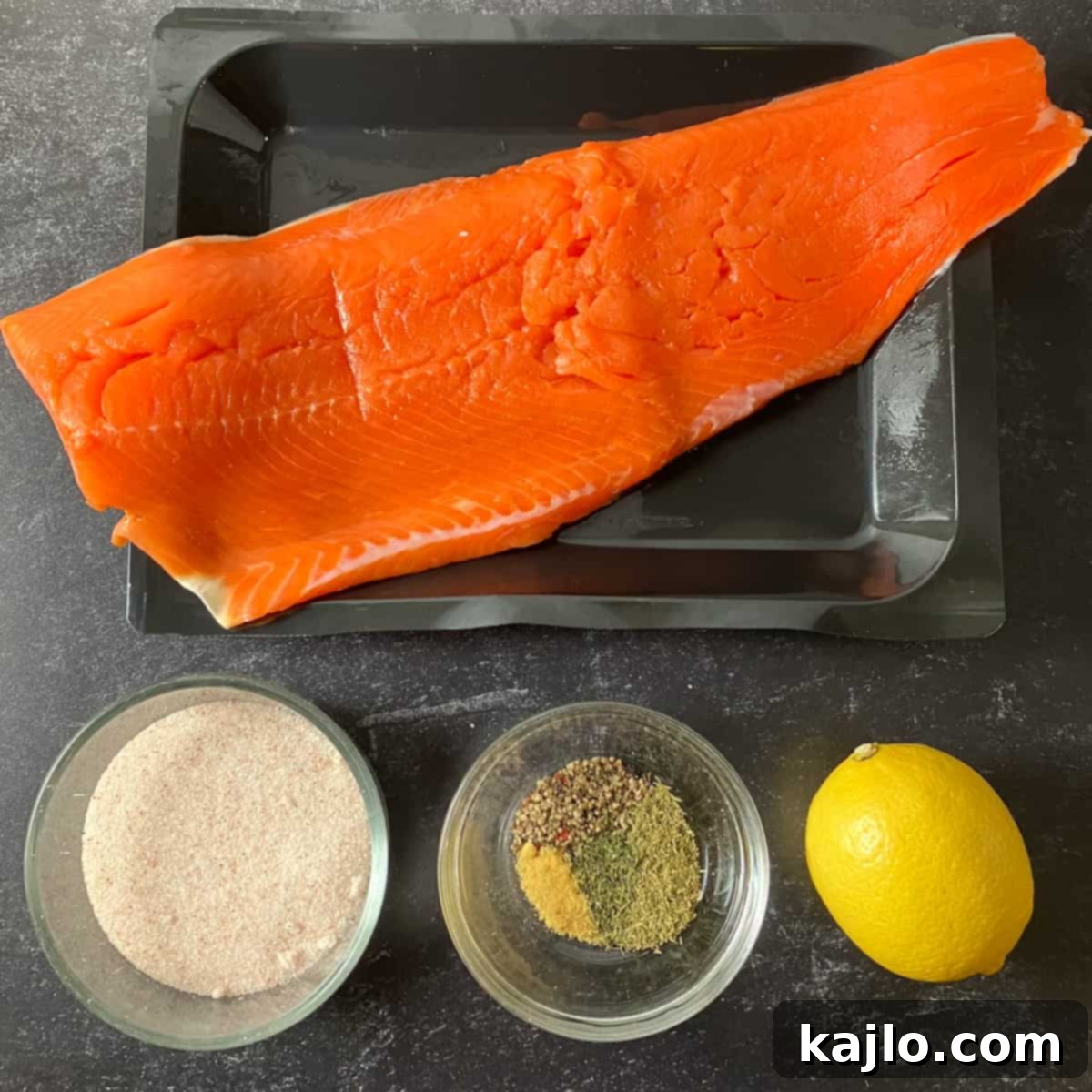
It’s important to use non-iodized salt for this recipe. Kosher salt, pickling salt, or canning salt are excellent choices. Avoid curing salts that contain nitrites, as they are used for different preservation methods and can alter the desired outcome of hot smoked salmon. Additionally, steer clear of iodized salt, as the iodine can impart an “off-flavor” to the fish during brining.
Some purists advise against using sea salt for brining due to potential impurities that could lead to undesirable flavors. However, I often use fine sea salt in this recipe and have never encountered this issue, suggesting that the quality of your sea salt and proper rinsing are key.
What cut of salmon is best for smoking?
Many culinary enthusiasts consider King salmon and Sockeye salmon to be the premier choices for smoking due to their rich, robust flavor and vibrant color. However, you can achieve excellent results with other varieties of salmon or even steelhead. Given that salmon can be expensive, feel free to choose fresh or frozen salmon that fits your budget for this recipe.
For ease of preparation, a boneless salmon fillet is highly recommended, as it eliminates the tedious task of removing pin bones. While you can smoke salmon without the skin, I prefer to leave the skin on. It helps keep the fillet intact, retains moisture, and makes handling easier during the smoking process.
How to Prepare and Brine Salmon for Smoking
Here are the detailed, step-by-step instructions for preparing and brining your salmon before smoking:
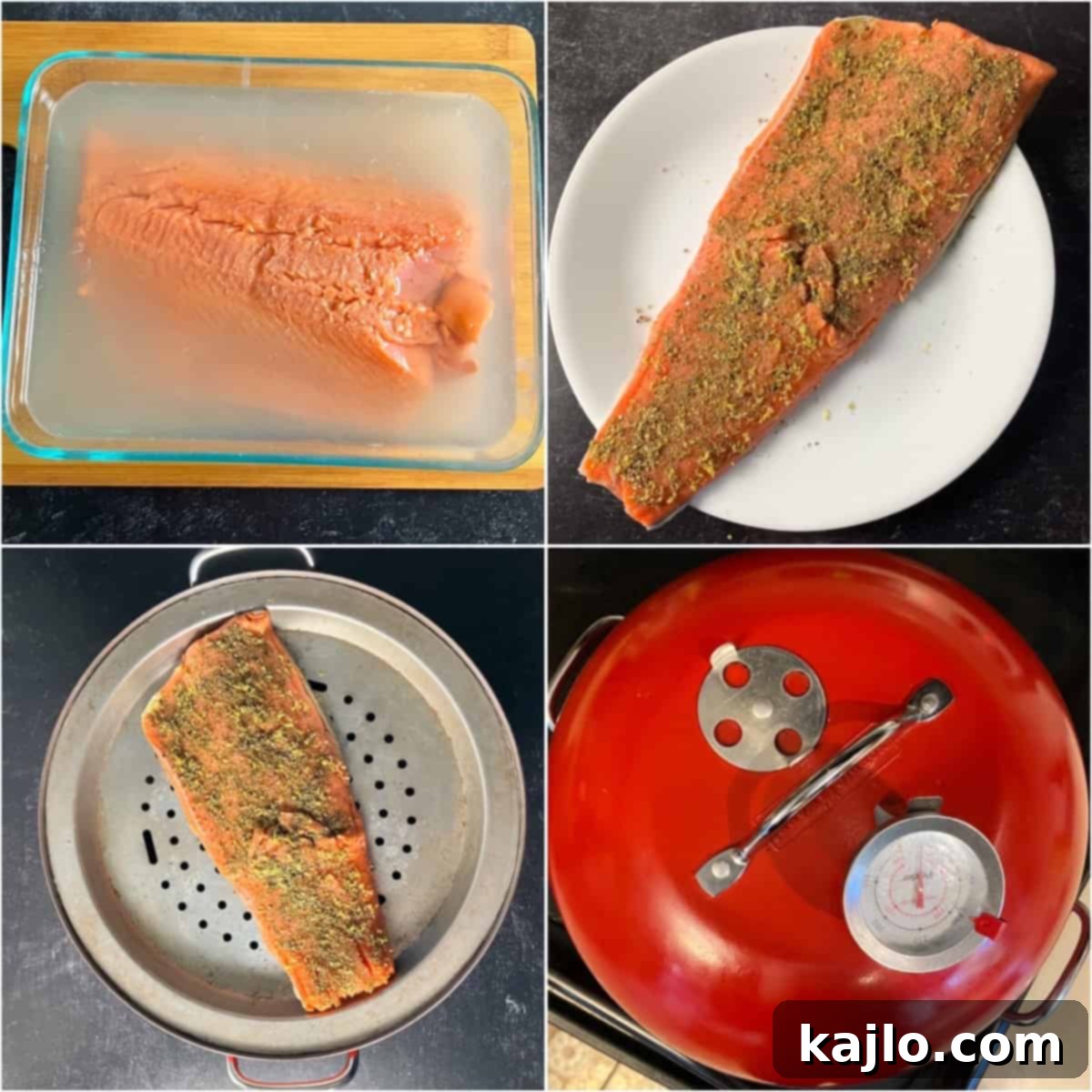
1. Prepare the Brine: In a saucepan, combine the kosher salt and water. Heat over medium heat, stirring continuously until the salt is completely dissolved. It’s important not to boil the solution; simply warm it enough to dissolve the salt. Once dissolved, remove the saucepan from the heat and allow the brine to cool completely to room temperature before proceeding.
2. Brine the Salmon: Place your salmon fillet in a small glass baking dish. Carefully pour the cooled saltwater brine over the salmon, ensuring it is fully submerged. Cover the dish and refrigerate the salmon in the brine for a full 24 hours. This allows the salt to properly penetrate and cure the fish.
3. Rinse and Pat Dry: After 24 hours, remove the salmon from the brine. Rinse it very thoroughly under cold running water to wash off any excess salt from the surface. Pat the salmon completely dry with paper towels. A dry surface is crucial for the next step.
4. Apply Seasoning Rub: In a small bowl, mix together the dried dill, black pepper, lemon zest, and mustard powder. Evenly rub this flavorful mixture over the skinless side of the salmon fillet. This blend will infuse the salmon with a delightful aromatic profile.
5. Form the Pellicle: Place the seasoned salmon in a single layer, uncovered, back into the refrigerator. Allow it to rest for 2-4 hours. This crucial step permits the formation of a “pellicle” – a slightly tacky, shiny film on the surface of the fish. The pellicle is essential as it helps the smoke flavor adhere better and seals in moisture during the smoking process, leading to a superior texture and taste.
How to Smoke Salmon
6. Set Up Your Smoker: Prepare your full-size Nordic Ware smoker by adding 2-3 tablespoons of shredded wood chips, specifically designed for smoking food, to the bottom of the unit. For this recipe, hickory chips (which often come with the smoker) are an excellent choice, providing a robust smoky flavor.
7. Arrange Salmon: Place the drip pan and the smoking tray inside the smoker. Arrange the salmon fillet, skin-side down, in a single layer on the smoking tray. If any edge of the salmon is particularly thin, you can gently fold it underneath itself to prevent it from drying out during smoking.
8. Prepare for Smoking: Secure the lid onto the smoker, ensuring the built-in thermometer is properly attached and the lid vent is closed. Crucially, turn on your stovetop vent fan to its highest setting if smoking indoors, to ensure proper ventilation.
9. Preheat the Smoker: Place the smoker on a stovetop burner and set the heat to medium-low. Allow the smoker’s thermometer to gradually rise and stabilize at 190°F (88°C). This gentle preheating helps create consistent smoke.
10. Smoke the Salmon: Once the temperature reaches 190°F (88°C), reduce the stovetop heat to low and set a timer for 20-30 minutes. The precise time will depend on the thickness of your salmon; for a ¼-inch (0.6cm) thick fillet, 20 minutes is often sufficient. Throughout the smoking period, diligently monitor the smoker’s temperature, ensuring it remains within the 190°F-210°F (88°C-99°C) range. You may need to make minor adjustments to the stovetop heat or briefly open the lid vent to control the temperature.
11. Manage Temperature Spikes: If you observe the smoker’s heat rising too quickly or exceeding the desired range, you can temporarily lift the lid for a brief moment. This simple action helps to release some heat and bring the temperature back down to the optimal smoking range.
12. Finish Smoking: After the designated smoking time, turn off the stovetop burner and carefully remove the salmon from the smoker. Immediately extinguish the hot wood chips by soaking them in water, ensuring safety.
13. Chill and Serve: Allow the smoked salmon to cool slightly, then refrigerate it until thoroughly chilled. Smoked salmon is traditionally served cold, offering a firm texture and pronounced smoky flavor that is remarkably similar to high-quality hot-smoked salmon found in specialty grocery stores. Enjoy your homemade delicacy!
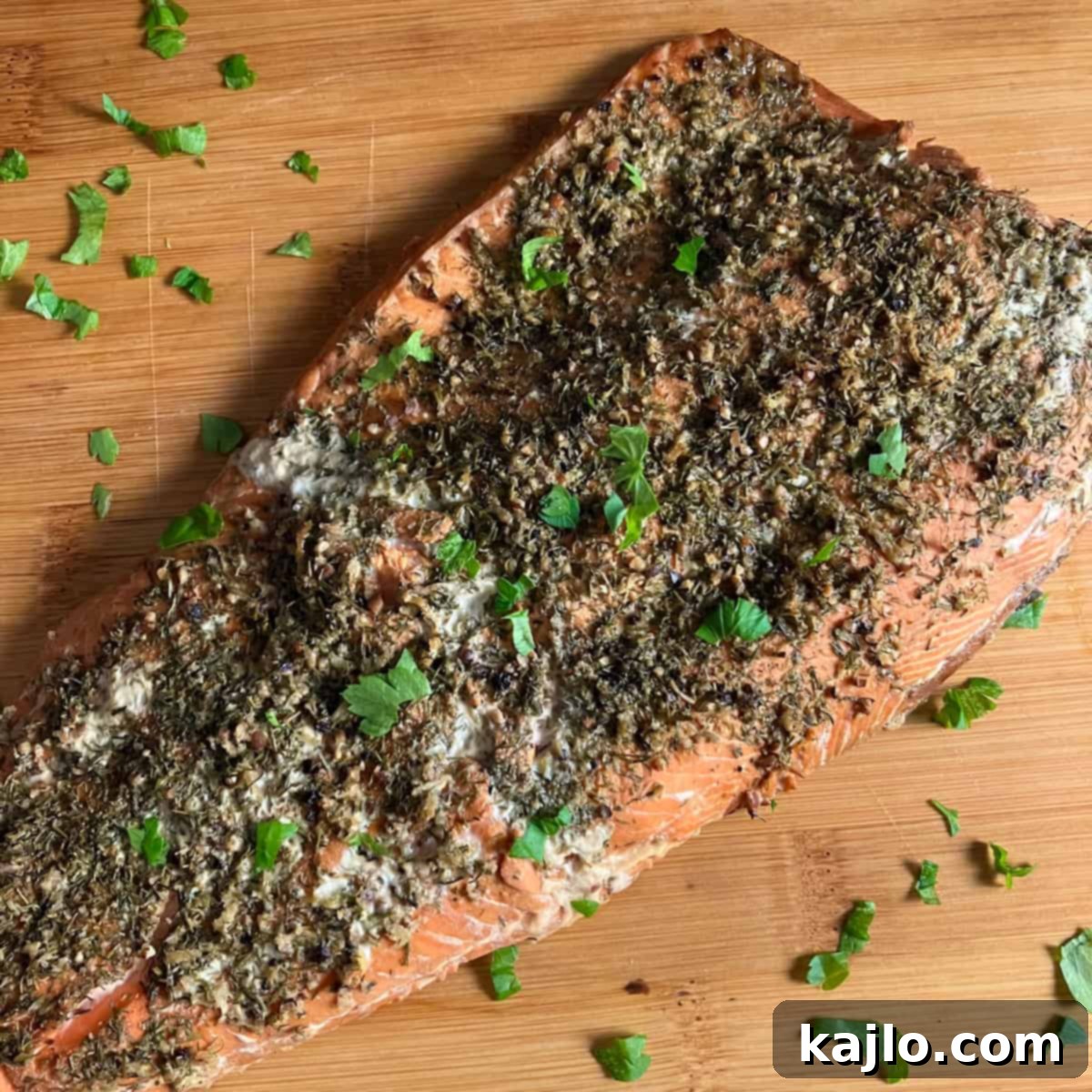
How long does it take to form a pellicle on a salmon in the refrigerator?
The time required for salmon to form a proper pellicle in the refrigerator typically ranges from 2 to 24 hours, largely depending on the thickness of the fish. For a thicker, approximately 1-inch (2.5 cm) piece of salmon, you should allocate about 6-8 hours for it to adequately dry and develop this crucial layer. A well-formed pellicle is essential for the smoke to adhere and for moisture retention during cooking.
🌡️ Internal Temp of Smoked Salmon
How do you know when smoked salmon is done? The definitive indicator of doneness for hot smoked salmon is its internal temperature. The minimum safe internal temperature for most fish, including salmon, is 145°F (63°C), as recommended by food safety authorities. However, for smoked fish, many culinary and food safety experts suggest aiming for a slightly higher internal temperature of at least 160°F (71°C) to further reduce the risk of harmful bacteria and ensure a more robustly cooked product.
Does smoked salmon need to be cooked or heated before eating?
Hot smoked salmon, by definition, is cooked during the smoking process to a safe internal temperature. Therefore, it typically does not require any additional cooking or heating before consumption. It is traditionally served chilled or at room temperature.
Cold smoked fish, on the other hand, is cured but not cooked during its smoking process. While generally not heated before eating either, it carries a higher food safety risk. To mitigate potential issues with parasites, it is strongly recommended that you freeze cold-smoked salmon (or the salmon prior to cold smoking) to a specific temperature for a specified duration to destroy any harmful organisms.
🪵 Best Wood to Smoke Salmon
What kind of smoke is best for salmon? According to many seasoned smoking enthusiasts and expert guides, alder wood is often considered the best choice for smoking salmon and other delicate fish. Alder imparts a mild, slightly sweet flavor that complements the richness of salmon without overpowering it. However, the world of wood smoking offers a variety of excellent options:
- Alder: Mild, slightly sweet, classic choice for fish.
- Apple: Mild, fruity, sweet smoke, great for a subtle flavor.
- Apricot: Similar to apple, with a light, fruity, sweet aroma.
- Cherry: Mild, fruity, subtly sweet, creates a beautiful mahogany color.
- Chestnut: Mild, nutty, similar to oak but lighter.
- Hickory: Strong, savory, bacon-like flavor; a bolder choice for those who love intense smoke.
- Maple: Mild, sweet, and gentle smoke, excellent for a balanced flavor.
- Mesquite: Very strong, earthy, and pungent; use sparingly to avoid bitterness.
- Nectarine: Light, fruity, and sweet, much like apple or peach.
- Oak: Medium, earthy, robust smoke; versatile and widely used.
- Peach: Mild, sweet, and fruity, infusing a delicate aroma.
- Pecan: Mild, nutty, and subtly sweet; a good alternative to hickory for less intensity.
- Plum: Fruity and slightly sweet, producing a beautiful reddish hue.
Ultimately, the “best” wood for smoking salmon comes down to personal preference and what is readily available to you. I personally favor the robust, distinctive flavor that hickory chips impart to smoked salmon, finding it to be a perfect complement to the fish’s richness. Don’t hesitate to experiment with different wood types to discover your own favorite!
❓ How Long is Smoked Salmon Safe to Eat After Smoking
What is the shelf life of smoked salmon and do I need to refrigerate it? Homemade hot smoked salmon, particularly when lightly salted (as in this recipe), is not as heavily preserved as some commercially vacuum-sealed products. Therefore, it absolutely requires refrigeration to maintain its safety and freshness. I recommend storing your homemade smoked salmon in an airtight container in the refrigerator for up to 3-4 days.
While some sources suggest that lightly salted and smoked fish can last up to two weeks in the refrigerator, I err on the side of caution due to varying smoking conditions and salt levels in home preparations. For longer-term storage, Nordic-style smoked salmon freezes exceptionally well. To freeze, wrap individual pieces of salmon tightly in plastic wrap, then place them in a freezer-safe bag, pressing out as much air as possible before sealing. Properly stored, frozen smoked salmon can maintain its quality for up to several months, allowing you to enjoy your delicious creation at your leisure.
😋 How Do I Prepare a Smoked Salmon Meal
For me, few things compare to the simple pleasure of salmon and cream cheese on a freshly toasted bagel on a lazy morning. Whether it’s cold-smoked or hot-smoked, and seasoned with a diverse blend of herbs and spices, as long as I get that unmistakable smoky salmon flavor, I’m content. It’s a versatile ingredient that elevates any meal.
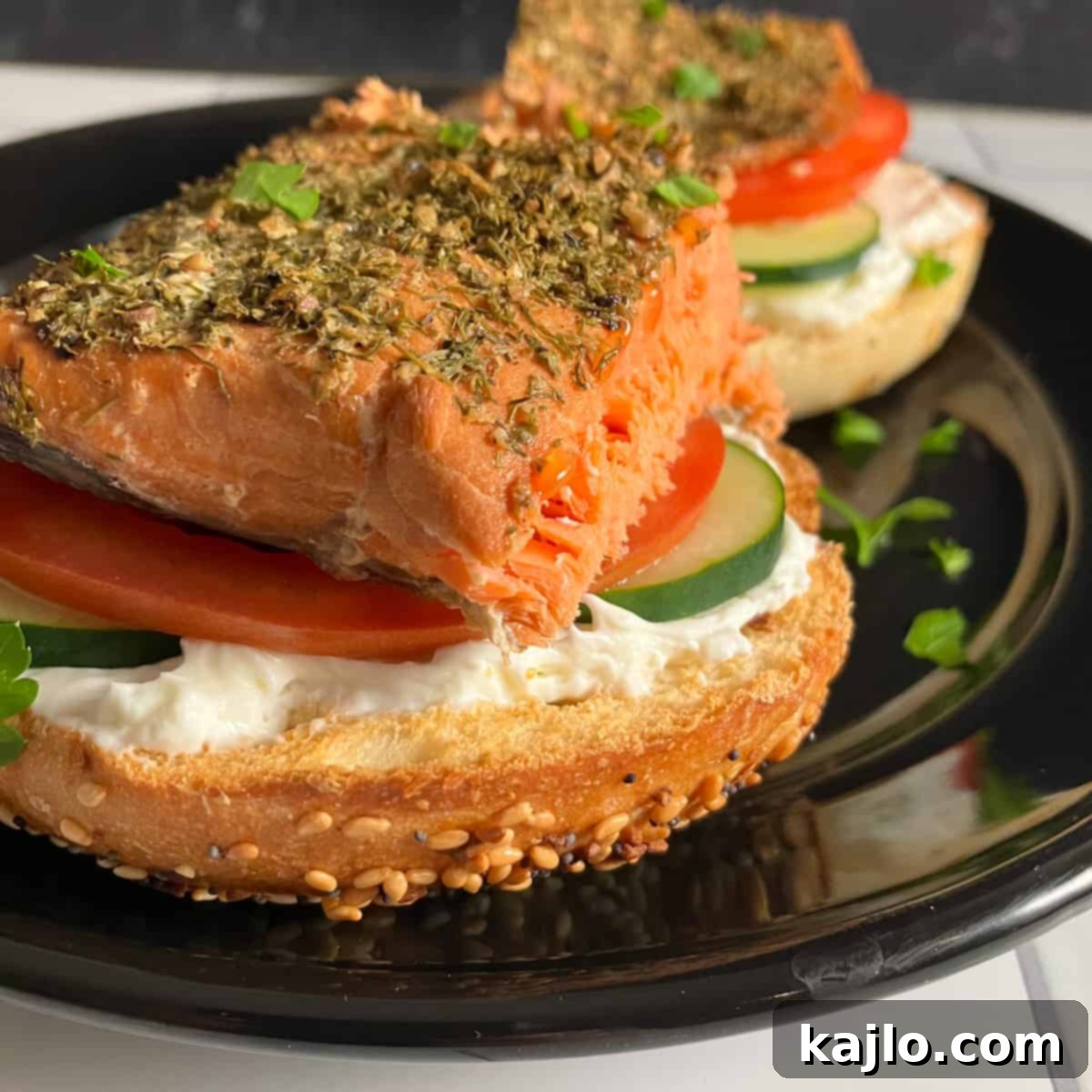
Beyond the classic bagel, here are a few more creative and delicious ways to incorporate smoked salmon into your meals:
- Create a vibrant Smoked Salmon Sushi Bowl with rice, avocado, cucumber, and a drizzle of spicy mayo.
- Fold it into creamy pasta dishes for an elegant and satisfying meal, perhaps inspired by a High Calorie Pasta for Weight Gain recipe, adding richness and protein.
- Transform it into a refreshing salmon salad by flaking the smoked fish and mixing it with mayonnaise, celery, red onion, and fresh herbs for sandwiches or crackers.
- Whip up a delectable smoked salmon dip by blending it with cream cheese, sour cream, lemon juice, and chopped dill, perfect for entertaining.
How Long to Smoke Salmon at 200 Degrees (Temperature Chart)
By Summer Yule
How long to smoke salmon at 200 degrees F (93C)? Find out here!
Prep Time: 30 mins
Cook Time: 30 mins
Total Time: 1 hr
Course: Breakfast, Slow Food DIY
Cuisine: Norwegian
Servings: 4
Calories: 162 kcal
Ingredients
- 1 lb salmon (454 grams; with skin, boneless)
- ⅓ cup kosher salt (not iodized salt)
- 4 cups water
- 1 teaspoon dried dill
- ½ teaspoon black pepper
- ½ teaspoon lemon zest
- ¼ teaspoon Colman’s mustard powder
Instructions
Put the salt and water in a saucepan over medium heat. Stir until the salt dissolves in the water. Do not boil the solution. Allow the brine to cool to room temperature.
Put the salmon in a small glass baking dish. Cover it completely with the saltwater brine. Let the salmon rest in the brine in the refrigerator for 24 hours.
After 24 hours, remove the salmon from the brine, rinse it very well with cold water, and pat it dry with paper towels.
Mix the dill, black pepper, lemon zest, and mustard powder together. Rub this mixture all over the skinless side of the salmon.
Let the seasoned salmon rest in a single layer in the refrigerator for 2-4 hours. This step is important to form the pellicle which will help the smoke flavor to adhere to the fish.
Set up your full-size Nordic Ware smoker with 2-3 tablespoons of shredded wood chips that are meant for smoking food. I used the hickory chips that came with the smoker.
Put the drip pan and smoking tray in the smoker. Put the salmon skin-side down in a single layer on the smoking tray. If the salmon has a very thin edge, you can fold it under so it doesn’t dry out.
Put the lid on the smoker. Ensure the thermometer is attached properly and the lid vent is closed. Turn your stovetop vent fan on.
Put the smoker on a stovetop burner and turn the heat to medium-low. Allow the smoker’s thermometer to come to 190°F (88°C).
Once the temperature comes to 190°F (88°C), turn the stovetop to low, and set a timer to smoke the salmon for 20-30 minutes. I chose to smoke the salmon for 20 minutes, because it was only ¼-inch thick (0.6cm). Make sure that the smoker stays in the 190°F-210°F (88°C-99°C) range for the entire smoking period. You may need to adjust the stovetop’s heat or open the vent on the lid. Keep a close eye on things!
If the heat on the smoker is rising too rapidly, you can always quickly lift the lid and peek at your salmon. This is an easy way to help bring the temperature back down.
After the timed smoking period, turn off the stovetop and remove the salmon from the smoker. Extinguish the spent wood chips by soaking them in water.
Refrigerate the salmon and serve it chilled. The end result is very similar to hot smoked salmon from a high-end grocery store. I hope that you enjoy it!
Equipment
- Indoor Smoker
- Wood Smoking Chips
Notes
💭 Expert Tips from Dietitian Summer Yule
This is a level 1 recipe (may help support fat loss). Is smoked salmon healthy? Salmon is a fatty fish that’s a rich source of the omega-3s DHA and EPA. This smoked salmon is also a nice way to get adequate protein in at breakfast (a meal where many of us fall short on protein).
For a higher calorie breakfast, serve smoked salmon fillet on a whole wheat bagel with cream cheese, plus fruit on the side. For a low-calorie or low-carb meal, try serving it with a veggie omelet instead. A cup of fresh strawberries would be great for a side dish and would not add much to the calorie or carb count.
The main disadvantage of this recipe is that the brine makes it fairly high sodium. If you’re on a low sodium diet, regular salmon that wasn’t smoked may be a healthier choice for you. Season it with fresh herbs, garlic, and lemon juice to add flavor.
Does smoked salmon carry any of the health risks of preserved meats such as bacon?
Smoking salmon produces potentially harmful polycyclic aromatic hydrocarbons (PAHs), similar to when bacon is smoked. For this reason (and the high salt content), I would vary the type of salmon in the diet, and not solely choose smoked salmon as your salmon source. Fresh salmon, frozen salmon, and canned salmon are some tasty alternatives to smoked salmon.
Nutrition information is for one serving. Sodium content may vary depending on how well the salmon is rinsed.
nutrition info disclaimer
All recipes on this website may or may not be appropriate for you, depending on your medical needs and personal preferences. Consult with a registered dietitian or your physician if you need help determining the dietary pattern that may be best for you.
The nutrition information is an estimate provided as a courtesy. It will differ depending on the specific brands and ingredients that you use. Calorie information on food labels may be inaccurate, so please don’t sweat the numbers too much.
“To taste” means to your preferences, which may have to be visual to follow food safety rules. Please don’t eat undercooked food.
Nutrition
Calories: 162kcal | Carbohydrates: 0.4g | Protein: 22.1g | Fat: 7g | Saturated Fat: 1g | Fiber: 0.1g | Vitamin A: 2.4% DV | Vitamin C: 0.2% DV | Calcium: 4.6% DV | Iron: 4.8% DV
Keywords: how long to smoke salmon, how long to smoke salmon at 200, how long to smoke salmon at 200 degrees, how to smoke salmon, Nordic Ware, NordicWare, salmon, smoker, smoking
Shop our cookbook! Easy Air Fryer Recipes for One
Burning your air fryer recipes?Here’s how to fix it!
FAQs
What makes smoked salmon so delicious?
Smoked salmon’s irresistible appeal lies in its complex flavor profile: the profound salty undertones, the savory umami, and the aromatic smokiness combine to create a truly unique taste experience. When recipes also incorporate a touch of sweetness from ingredients like maple syrup or brown sugar, it taps into the universally loved combination of fat, salt, and carbs. This harmonious blend, found in many beloved comfort foods, is precisely what makes each bite of smoked salmon so profoundly satisfying and memorable.
How to cold smoke salmon?
General safety instructions for cold smoked salmon emphasize strict adherence to temperature control and prior preparation. It’s crucial to understand that cold smoking carries a higher food safety risk than hot smoking because the fish is not cooked to destroy bacteria. If your cold-smoked salmon will be consumed without further cooking, it is highly recommended to freeze and thaw the fish beforehand. This freezing step is vital for eliminating potential harmful parasites that might be present in raw fish, making the final product safer to eat.
How many calories in smoked salmon?
This particular smoked salmon recipe provides approximately 162 calories per serving, along with 0.4 grams of carbohydrates and a substantial 22.1 grams of protein. This makes it an excellent choice for those following low-carb, keto, gluten-free, or dairy-free dietary patterns, offering a flavorful and nutrient-dense option that fits various health goals.
Is smoked salmon lox?
No, smoked salmon and lox are distinct products, although they are often confused. Traditionally, lox refers to salmon that has been cured with salt but not smoked. It has a very silky, translucent texture. However, the term “lox” is sometimes colloquially used to describe Nova-style salmon, which is salmon that has been both cured and cold-smoked. The hot-smoked salmon prepared in this recipe is fully cooked during the smoking process and, by any traditional definition, would not be considered lox.
What is the white stuff on smoked salmon?
The white substance that sometimes appears on hot-smoked salmon is a coagulated protein known as albumin. It’s a natural occurrence and a small amount of white stuff is perfectly normal and harmless to consume. However, if you observe a significant amount of albumin on your smoked salmon, it’s generally an indicator that the fish has been overcooked. This can happen if the temperature was too high or the cooking time too long, causing the proteins to denature rapidly.
Why is my smoked salmon mushy?
If your homemade smoked salmon turns out mushy, there are primarily two common culprits. First, leaving the salmon in the salty brine for too long can cause it to break down and become overly soft. The brine’s purpose is to cure, not to tenderize excessively. Second, overcooking the salmon, even at a lower smoking temperature, can lead to a mushy texture as the delicate fish proteins become too denatured and lose their structure.
Why is my smoked salmon pink?
The vibrant pink hue of salmon, whether cold-smoked or hot-smoked, comes from a naturally occurring pigment called astaxanthin, which is found in the diets of both wild-caught and farmed salmon. Cold-smoked salmon, which is not cooked, typically retains a brighter, more translucent pink color compared to hot-smoked salmon, which is cooked through and tends to have a more opaque, paler pink appearance.
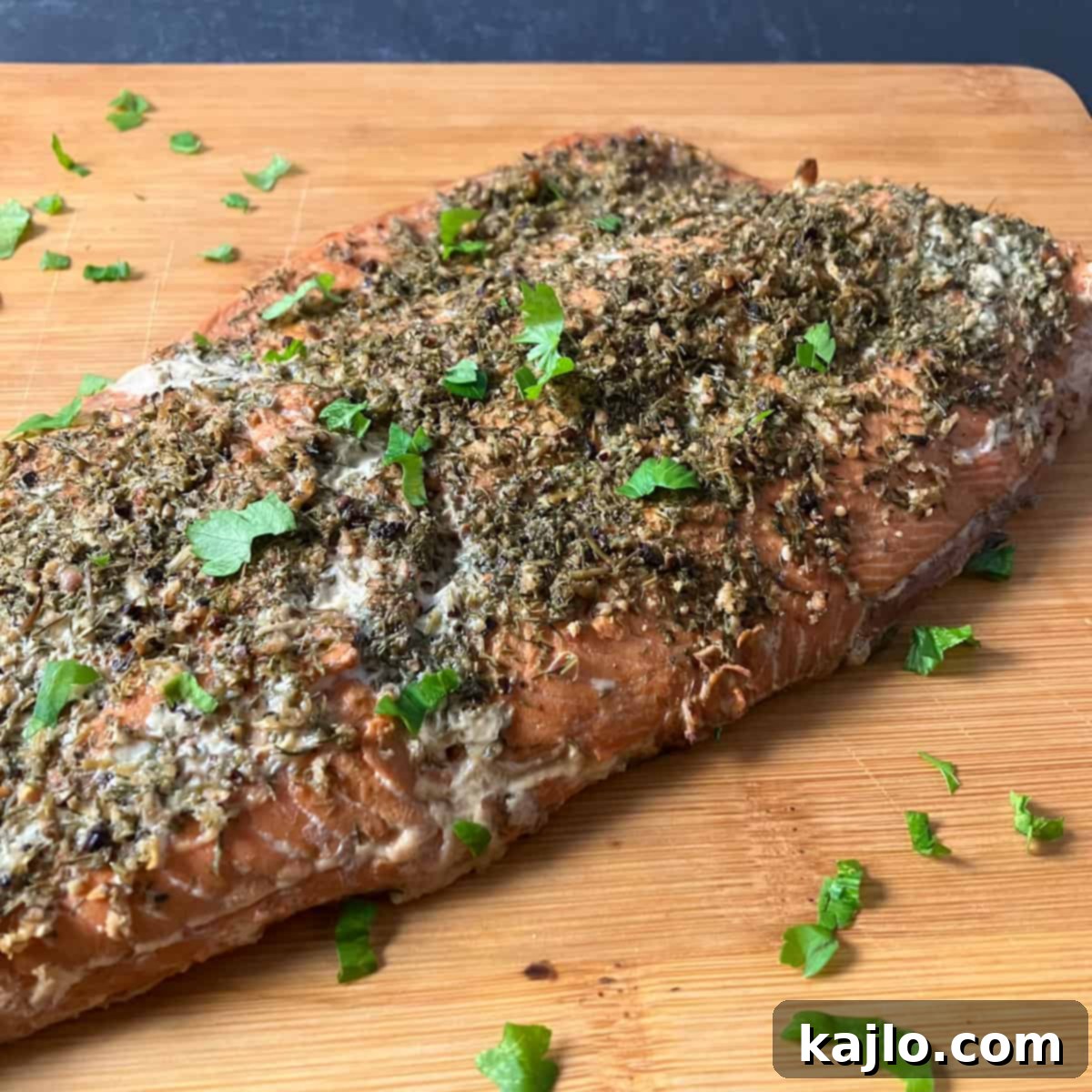
👩🏻🍳 Other Nordic Ware Stovetop Smoker Recipes
If you’re eager to explore more possibilities with your Nordic Ware stovetop smoker, you’re in luck! While the smoker typically comes with a basic chart for approximate smoking times and a handful of introductory recipes, many users find themselves craving more detailed guidance and creative ideas for various proteins and vegetables.
The Nordic Ware smoker is incredibly versatile, allowing you to replicate many dishes you might traditionally make in a large outdoor smoker, but in a more compact and often indoor-friendly setting. Here are some fantastic recipes that demonstrate the breadth of what you can achieve with this handy appliance:
- Smoked Stouffer’s Mac and Cheese: Elevate a classic comfort food with rich, smoky notes.
- Smoked Burgers: Infuse your burgers with deep smoke flavor for an unforgettable BBQ experience.
- How to Smoke Tofu in a Smoker: A fantastic option for plant-based enthusiasts looking to add smoky depth to their tofu.
- Smoked Portobello Mushrooms: Transform ordinary mushrooms into a flavorful side dish or meat substitute.
Don’t limit yourself to these; feel free to experiment with smoking ribs, chicken, pork roast, or virtually any food you’d consider for an outdoor smoker. The possibilities are truly endless!
👨🏾🍳 More Salmon Recipes
If you’ve enjoyed mastering smoked salmon and are looking for more ways to prepare this versatile and nutritious fish, here are some additional salmon recipes to inspire your culinary adventures. These recipes explore different cooking methods and flavor profiles, ensuring you always have a fresh take on salmon:
- Frozen Salmon in the Air Fryer: A quick and easy method for cooking salmon directly from frozen, perfect for busy weeknights.
- Air Fryer Salmon Patties: A delicious and healthy way to use canned or leftover salmon, often served with a zesty lemon-dill tartar sauce.
- Costco Stuffed Salmon: Learn how to recreate or enhance the popular pre-made stuffed salmon for an impressive meal.
- How Long to Bake Salmon at 375: A guide to perfectly baked salmon, ensuring it’s flaky and moist every time.
Join our community! Subscribe for all of the latest and greatest recipes, and follow me on Facebook, Pinterest, Instagram, and YouTube!
